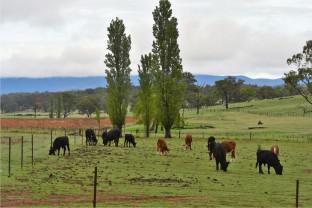Agronomy for Sustainable Development ( IF 6.4 ) Pub Date : 2023-01-03 , DOI: 10.1007/s13593-022-00863-8 Md Nurul Amin , Lisa Lobry de Bruyn , Andrew Lawson , Brian Wilson , Md Sarwar Hossain

|
Previous research on increasing soil carbon sequestration, through soil carbon management (SCM), has not integrated social components into the ecological system. To understand how experienced farmers combine social and ecological components of soil carbon management practices, we have used a social-ecological systems (SES) framework. This study examines the distribution and pattern of farmers’ SCM practices, comparing and contrasting two farming cohorts based on inherent soil fertility in a rotational grazing regime of sub-tropical temperate grazing lands in Australia. Twenty-five grazing farmers with the land of low (n= 13) and moderate (n=12) fertility soils were interviewed about SCM and how they have maintained their grazing regime despite climatic constraints using the SES framework. Both farming cohorts (low-fertility farms and moderate-fertility farms) have shown resolve to continue their grazing regime because the benefits were manifold and affected the whole-farm sustainability. Farmers with low-fertility farms highlighted a number of SCM outcomes but were less confident of achieving them. Farmers were focused on the agri-environmental benefits of SCM practices in a holistic manner, rather than a single goal of increasing soil carbon. The interviewed farmers reported a number of benefits that accrue from their grazing regimes, including improvements in production, soil moisture retention, and soil health, even though some of these benefits were not measured. Farmers in more “stressed” environments, with low soil fertility, also emphasized mental health and landscape esthetics as outcomes of SCM. These features of the farmers’ SCM provide important benefits that are not easily quantified but are also instrumental in encouraging other farmers to manage their soil. Long-term practitioners of rotational grazing such as the farmers in this study can provide useful insights for a more targeted, customized, and nuanced government policy that focuses on whole-farm sustainability, which can also improve soil carbon stocks in similar regions of Australia.
中文翻译:

从农民在澳大利亚放牧制度下土壤碳管理实践中吸取的教训
以往关于通过土壤碳管理 (SCM) 增加土壤碳固存的研究并未将社会成分整合到生态系统中。为了解经验丰富的农民如何结合土壤碳管理实践的社会和生态组成部分,我们使用了社会生态系统 (SES) 框架。本研究考察了农民 SCM 实践的分布和模式,比较和对比了澳大利亚亚热带温带牧场轮牧制度中基于固有土壤肥力的两个农业队列。25 个牧场农户,土地面积为低(n = 13)和中(n=12) 肥沃的土壤接受了关于 SCM 的采访,以及他们如何使用 SES 框架在气候限制的情况下保持放牧制度。两个农业队列(低肥力农场和中等肥力农场)都表现出继续放牧的决心,因为好处是多方面的,并影响了整个农场的可持续性。低肥力农场的农民强调了一些供应链管理成果,但对实现这些成果信心不足。农民以整体方式关注 SCM 实践的农业环境效益,而不是增加土壤碳的单一目标。接受采访的农民报告了他们的放牧制度带来的许多好处,包括提高产量、土壤水分保持和土壤健康,尽管其中一些好处没有得到衡量。在土壤肥力低的“压力”更大的环境中,农民也强调心理健康和景观美学是 SCM 的成果。农民 SCM 的这些特征提供了不容易量化的重要好处,但也有助于鼓励其他农民管理他们的土壤。轮牧的长期实践者(例如本研究中的农民)可以为更有针对性、定制化和细致入微的政府政策提供有用的见解,这些政策侧重于整个农场的可持续性,这也可以改善澳大利亚类似地区的土壤碳储量。农民 SCM 的这些特征提供了不容易量化的重要好处,但也有助于鼓励其他农民管理他们的土壤。轮牧的长期实践者(例如本研究中的农民)可以为更有针对性、定制化和细致入微的政府政策提供有用的见解,这些政策侧重于整个农场的可持续性,这也可以改善澳大利亚类似地区的土壤碳储量。农民 SCM 的这些特征提供了不容易量化的重要好处,但也有助于鼓励其他农民管理他们的土壤。轮牧的长期实践者(例如本研究中的农民)可以为更有针对性、定制化和细致入微的政府政策提供有用的见解,这些政策侧重于整个农场的可持续性,这也可以改善澳大利亚类似地区的土壤碳储量。











































 京公网安备 11010802027423号
京公网安备 11010802027423号